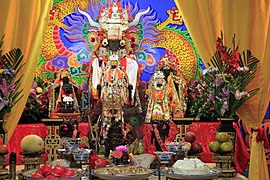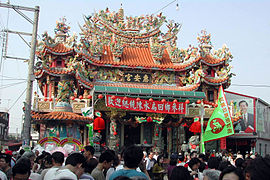Taiwanese folk beliefs
This article has an unclear citation style. (July 2022) |

Taiwanese folk beliefs are traditional beliefs widely circulated in Taiwan, including Chinese people's beliefs that combine Daoism, Buddhism, and Confucianism. These also include the deification of local heroes and celebrities, Wang Ye worship, and Taiwanese aborigines's Ancestors. Ancestral Spirituality, the former, along with the China Minnan region and Guangdong immigrants from the South China region, crossed the Taiwan Strait to the east and took root in Taiwan. Gradually, folk beliefs with local styles emerged, but by and large, the original Chinese people's interfaith gods are still worshipped; the second shows that Taiwanese people are full of feelings of tolerance and knowledge, such as worshipping the Japanese soldiers who sacrificed their lives to save the people; the second, such as Ying Gong and Wan Shan Yi in various places, and some are even more spirit, such as Nan Kunshen Dai Some of the latter still retain their original characteristics, while some beliefs (such as Ali-zu beliefs) have been Sinicized. Taiwan is also the most religious region in the Chinese world, with 93% of people following mixture of Buddhism, Confucianism, and Taoism, Christian 4.5%, other 2.5%.[1]
Chinese folk religion in Taiwan is framed by the ritual ministry exerted by the Zhengyi Taoist clergy (sanju daoshi), independent orders of fashi (non-Taoist ritual masters), and tongji media. The Chinese folk religion of Taiwan has characteristic features, such as Wang Ye worship.[2] Even though Falun Gong is banned in China, people in Taiwan are free to practise it.[3]
Gallery
[edit]-
Folk Taoists officiating a ceremony in Taichung.
-
An altar dedicated to various gods at a temple in Tainan.
-
Temple of Fude in Wujie, Yilan.
-
Hui'an Temple in Kuantien, Tainan. The festival welcomed politician Chen Shui-bian home after his 2004 re-election.
-
Hotsu Longfong Temple dedicated to Mazu in Miaoli.
-
Temple of Guandi in Hsinchu.
References
[edit]Footnotes
[edit]- ^ mixture of Buddhist, Confucian, and Taoist 93%, Christian 4.5%, other 2.5%《The Global Situation》Quinton Crawford (2010)
- ^ Clart & Jones (2003), Ch. 5 (p. 98-124).
- ^ 中央管法輪功廣告,台南市長認為不妥。 (in Chinese). Executive Yuan.
Bibliography
[edit]- Rubinstein, Murray A. (2014). Taiwan: A New History. Routledge. ISBN 9780765614957.
- Clart, Philip; Jones, Charles B., eds. (2003). Religion in modern Taiwan: tradition and innovation in a changing society. Honolulu: University of Hawai'i Press. ISBN 9780824825645.
- Clart, Philip; Ownby, David; Wang, Chien-chuan (2010). "Text and Context: Redemptive Societies in the History of Religions of Modern and Contemporary China". University of Leipzig.
- Brown, Deborah A.; Cheng, Tun-jen (January 2012). "Religious Relations across the Taiwan Strait: Patterns, Alignments, and Political Effects" (PDF). Orbis. 56 (1): 60–81. doi:10.1016/j.orbis.2011.10.004.






